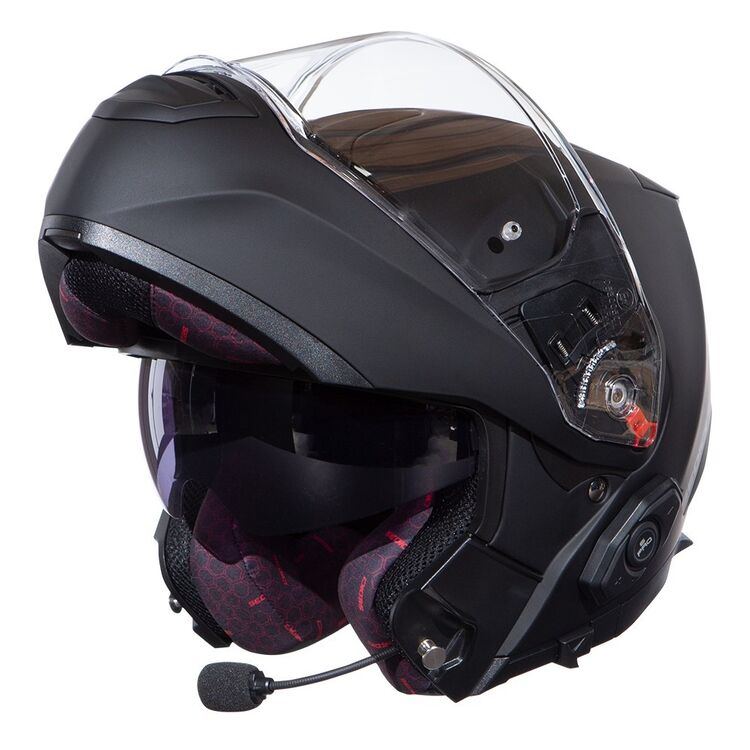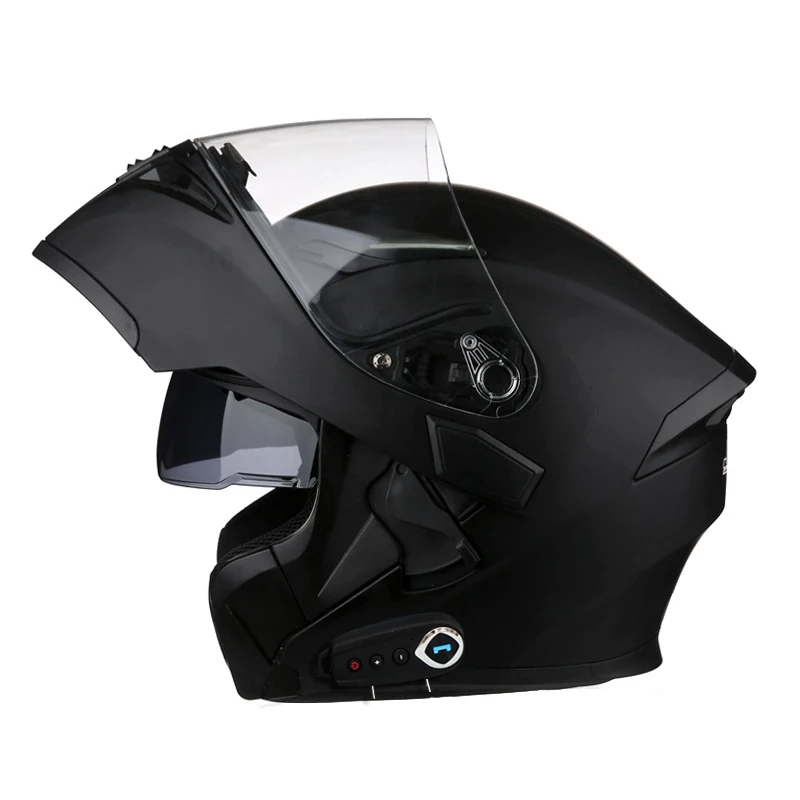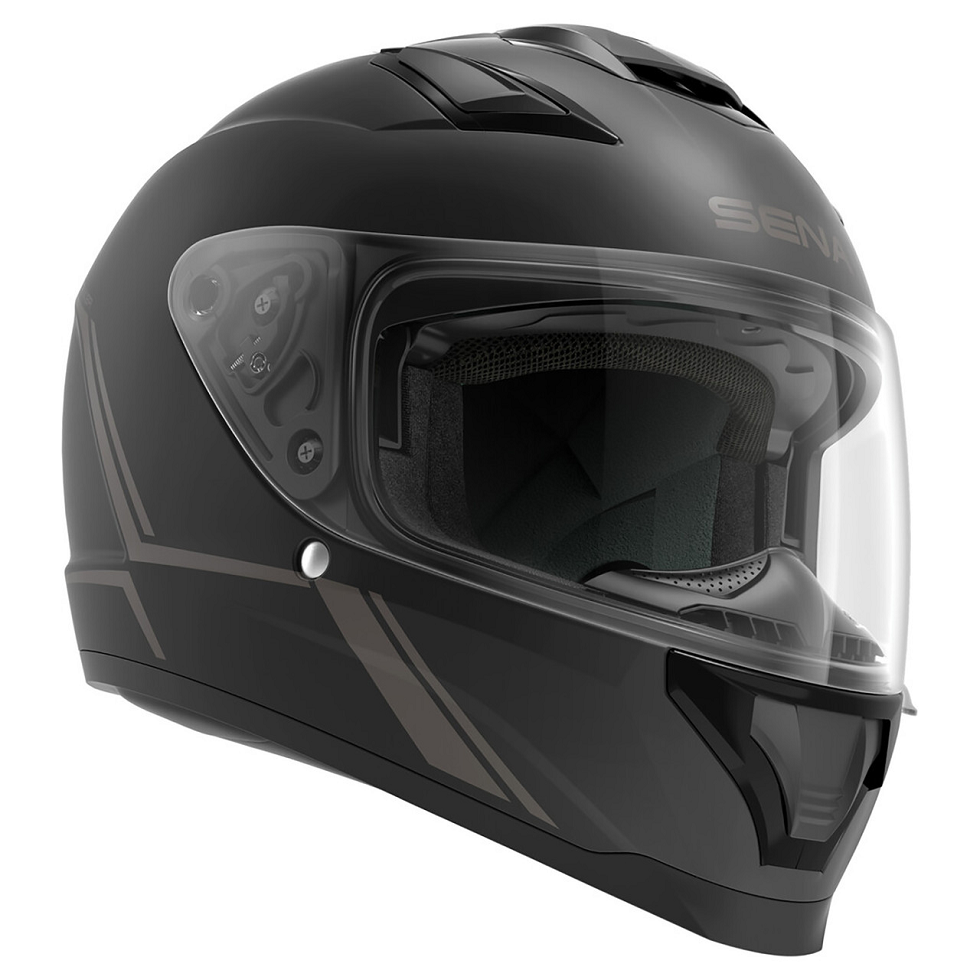Bluetooth helmets are revolutionizing the way we ride, blending the traditional protection of helmets with advanced communication technologies. These helmets integrate Bluetooth capabilities, allowing riders to stay connected, communicate, and access various multimedia features without compromising safety. This article explores the history, features, benefits, popular models, and future advancements of Bluetooth helmets, highlighting their growing significance in modern riding experiences.
The Evolution of Bluetooth Helmets
Early Development and Market Introduction
The concept of Bluetooth helmets stemmed from the need to enhance communication and multimedia access for riders without compromising safety. Before their introduction, traditional helmets offered minimal connectivity, relying on basic intercom systems that were often cumbersome and limited in range.
As Bluetooth technology advanced in the early 2000s, manufacturers saw the potential to integrate wireless communication features into helmets. The initial models were basic, offering simple intercom functions for rider-to-passenger communication. These early Bluetooth helmets paved the way for more sophisticated designs by proving the feasibility and demand for such features.
The introduction of more advanced Bluetooth helmets in the mid-2000s marked a significant milestone. These helmets incorporated multi-channel connections, allowing riders to link their helmets with smartphones, GPS systems, and other devices. As technology evolved, Bluetooth helmets became more reliable, user-friendly, and versatile, catering to the growing needs of modern riders.
Technological Advancements and Market Growth
The evolution of Bluetooth helmets has been driven by continuous advancements in both helmet design and Bluetooth technology. Modern Bluetooth helmets offer a range of features, including hands-free calling, music streaming, GPS navigation, and rider-to-rider communication, enhancing the overall riding experience.
Improvements in Bluetooth technology, such as Bluetooth 4.0 and 5.0, have increased connectivity range, data transfer speeds, and battery efficiency. These advancements have made Bluetooth helmets more practical and convenient for everyday use. Manufacturers have also focused on developing noise-cancellation and advanced microphone systems to ensure clear communication even in noisy riding environments.
The growing popularity of Bluetooth helmets has led to increased competition among manufacturers. This competition has resulted in more innovative designs, better functionality, and a broader range of options for consumers. Today, Bluetooth helmets are available in various styles, including full-face, modular, and open-face designs, catering to diverse preferences and riding needs.
Essential Features of Bluetooth Helmets
Integrated Communication Systems
One of the primary features of Bluetooth helmets is their integrated communication systems. These systems allow riders to communicate effortlessly with passengers or fellow riders. Bluetooth intercoms provide clear, hands-free communication, which is essential for coordinating rides, discussing routes, or sharing experiences.
Modern Bluetooth helmets offer multi-channel intercom capabilities, enabling group communication with up to 8 or more riders. This group intercom feature is particularly useful for group rides, allowing everyone to stay connected and informed. Advanced intercom systems offer extended range, sometimes up to a mile or more, ensuring reliable communication even over long distances.
The integration of voice command features further enhances communication convenience. Riders can use voice commands to answer calls, change music tracks, or access GPS directions without taking their hands off the handlebars. This hands-free operation contributes to a safer and more enjoyable riding experience.
Multimedia and Entertainment
Bluetooth helmets provide access to various multimedia features, enhancing the overall riding experience. Riders can stream music, listen to radio broadcasts, or enjoy audiobooks while on the move. The ability to access multimedia content seamlessly adds entertainment and reduces the monotony of long rides.
The built-in speakers and audio systems in Bluetooth helmets are designed for high-quality sound. Manufacturers use advanced speaker technology to deliver clear, crisp audio even at high speeds. Some helmets include bass-enhancing features and customizable sound profiles, allowing riders to tailor the audio experience to their preferences.
In addition to music and audio entertainment, Bluetooth helmets can connect to GPS systems for turn-by-turn navigation. Riders can receive real-time directions without needing to glance at maps or GPS devices, keeping their focus on the road. This integration of navigation aids in safer riding and more efficient route planning.
Safety and Convenience Features
Safety remains a top priority for Bluetooth helmets. In addition to the standard protective features of traditional helmets, Bluetooth helmets incorporate advanced safety technologies. Features such as emergency call systems can automatically notify emergency contacts in the event of an accident, providing an added layer of security.
Bluetooth helmets are designed to meet rigorous safety standards, including DOT (Department of Transportation) and ECE (Economic Commission for Europe) certifications. These certifications ensure that the helmets provide adequate protection in case of an impact. The integration of Bluetooth technology does not compromise the structural integrity or safety features of the helmets.
The convenience features of Bluetooth helmets further enhance their appeal. Many models offer easy-to-use control interfaces, including touch-sensitive buttons and jog dials. These controls are designed to be operated effortlessly, even with gloved hands. Some helmets also provide smartphone apps for remote control and customization of settings, adding to the overall user experience.
Battery Life and Charging
Battery life is a critical consideration for Bluetooth helmets. The continuous use of Bluetooth features can drain the battery, so manufacturers prioritize long-lasting and efficient power systems. Modern Bluetooth helmets are equipped with high-capacity batteries that provide extended usage time, often ranging from 8 to 20 hours of talk time or audio playback.
The inclusion of fast-charging technology ensures that riders can quickly recharge their helmets during breaks. Some helmets offer USB-C charging ports, allowing for convenient and rapid charging using standard cables and adapters. The ability to recharge the helmet quickly and efficiently adds to the practicality and convenience of Bluetooth helmets.
Battery management features, such as low-battery notifications and power-saving modes, help riders monitor and optimize battery usage. These features ensure that the helmet remains functional and ready for use throughout the ride. The continuous improvements in battery technology contribute to the overall reliability and performance of Bluetooth helmets.
Advantages of Bluetooth Helmets
Enhanced Communication and Connectivity
One of the most significant advantages of Bluetooth helmets is their enhanced communication and connectivity capabilities. Riders can stay connected with friends, family, and fellow riders without needing to stop or pull over. The hands-free communication provided by Bluetooth helmets ensures that riders can communicate safely and conveniently while on the move.
The ability to pair with smartphones enables riders to make and receive phone calls seamlessly. This feature is particularly useful for staying in touch with loved ones, coordinating schedules, or handling emergencies. The integration of voice command systems allows riders to control their devices without taking their hands off the handlebars, enhancing safety and convenience.
Group intercom features enable riders to communicate with multiple participants simultaneously. This capability is invaluable for group rides, touring, and event coordination. The extended range and clear communication provided by advanced intercom systems ensure that everyone remains connected and informed throughout the ride.
Bluetooth helmets provide access to a wide range of multimedia and navigation features, enhancing the overall riding experience. Riders can enjoy their favorite music, podcasts, or audiobooks, making long rides more enjoyable and entertaining. The high-quality audio systems in Bluetooth helmets deliver clear and immersive sound, even at high speeds.
The integration of GPS navigation is another significant advantage of Bluetooth helmets. Riders can receive turn-by-turn directions without needing to look at maps or GPS devices, keeping their focus on the road. This hands-free navigation aids in safer riding and efficient route planning.
The ability to access real-time traffic updates, weather forecasts, and other information through connected smartphones ensures that riders stay informed and prepared. These multimedia and navigation features contribute to a more enjoyable, efficient, and safe riding experience.
Improved Safety and Convenience
Bluetooth helmets enhance rider safety by incorporating advanced communication and convenience features. The hands-free operation ensures that riders can communicate and access multimedia content without taking their hands off the handlebars. This focus on safety reduces distractions and allows riders to maintain better control of their vehicles.
Emergency call systems and location-sharing features add an extra layer of security. In the event of an accident, these features can automatically notify emergency contacts or provide real-time location updates. This rapid response can be critical in ensuring timely assistance and support.
The convenience features of Bluetooth helmets, such as easy-to-use controls and smartphone apps, enhance the overall user experience. Riders can customize settings, manage connections, and monitor battery life effortlessly. These features ensure that Bluetooth helmets are practical and user-friendly, catering to the needs of modern riders.
Versatility and Multi-Functionality
Bluetooth helmets offer versatility and multi-functionality, making them a valuable accessory for various riding scenarios. The ability to connect multiple devices, such as smartphones, GPS systems, and communication headsets, ensures that riders can access a wide range of functions and features.
The modular design of some Bluetooth helmets allows for easy upgrades and customization. Riders can add or remove components, such as communication units, speakers, and microphones, based on their preferences and needs. This adaptability ensures that Bluetooth helmets remain relevant and functional over time.
Bluetooth helmets are suitable for various types of riding, including commuting, touring, adventure riding, and group rides. The combination of communication, multimedia, and safety features makes them a versatile and multi-functional accessory that enhances the overall riding experience.
Exploring Popular Bluetooth Helmet Models
Sena Momentum EVO Bluetooth-Integrated Helmet
The Sena Momentum EVO Bluetooth-Integrated Helmet is a premium option known for its advanced features and high-quality construction. This helmet is designed to provide seamless communication and multimedia access, enhancing the overall riding experience. The Momentum EVO is widely used by riders who prioritize connectivity and performance.
The helmet’s shell is constructed from a lightweight composite fiberglass material, offering excellent protection and durability. The aerodynamic design reduces wind noise and drag, ensuring a comfortable and enjoyable ride. The interior padding is designed for both comfort and impact absorption, with moisture-wicking and antimicrobial properties.
The Momentum EVO helmet features Sena’s proprietary Bluetooth 4.1 technology, providing clear and reliable communication. The helmet includes integrated speakers and a microphone, offering hands-free calling, music streaming, and GPS navigation. The group intercom feature allows communication with up to 8 riders, with an extended range of up to a mile.
The helmet also includes advanced noise control and voice command features, ensuring clear communication even in noisy environments. The built-in ventilation systems improve airflow and reduce heat buildup, enhancing overall comfort. The Sena Momentum EVO Bluetooth-Integrated Helmet’s combination of advanced features, protection, and comfort makes it a top choice for modern riders.
Cardo Freecom 4+ Bluetooth Helmet Communication System
The Cardo Freecom 4+ Bluetooth Helmet Communication System is a versatile option that can be integrated into various helmet styles, providing advanced communication and multimedia features. This system is designed to enhance connectivity and convenience, catering to the needs of modern riders.
The Freecom 4+ system includes a compact Bluetooth unit that can be attached to the helmet’s exterior, along with integrated speakers and a microphone. This modular design allows for easy installation and customization. The system is compatible with full-face, modular, and open-face helmets, ensuring versatility and adaptability.
The Cardo Freecom 4+ system features Bluetooth 4.1 technology, providing clear and reliable communication. The group intercom feature allows communication with up to 4 riders, with an extended range of up to three-quarters of a mile. The system also includes noise-canceling technology and voice command features, ensuring clear communication in various riding environments.
The Freecom 4+ system supports hands-free calling, music streaming, and GPS navigation, enhancing the overall riding experience. The system’s intuitive control interface includes touch-sensitive buttons and a jog dial, providing easy operation even with gloved hands. The combination of advanced features and modular design makes the Cardo Freecom 4+ a popular choice for Bluetooth communication.
Bluetooth Helmet ILM Full Face Motorcycle Helmet
The Bluetooth Helmet ILM Full Face Motorcycle Helmet is a budget-friendly option that offers reliable communication and multimedia features. This helmet is designed to provide essential Bluetooth connectivity while maintaining a high level of protection and comfort.
The helmet’s shell is constructed from an ABS composite material, offering good impact resistance and durability. The aerodynamic design reduces wind noise and drag, ensuring a comfortable ride. The interior padding is designed for impact absorption and comfort, with moisture-wicking and removable liners for easy maintenance.
The ILM Full Face Bluetooth Helmet features built-in Bluetooth speakers and a microphone, providing hands-free calling, music streaming, and GPS navigation. The Bluetooth 3.0 technology ensures reliable communication, with a range of up to 1,000 feet. The helmet includes noise-reduction technology, ensuring clear audio even at high speeds.
The helmet’s control interface includes easy-to-use buttons and a built-in sun visor for added convenience. The ventilation systems improve airflow and reduce heat buildup, enhancing overall comfort. The combination of affordability, protection, and basic Bluetooth features makes the ILM Full Face Motorcycle Helmet a practical choice for riders seeking connectivity on a budget.
Future Advancements in Bluetooth Helmets
Integration of Advanced Technologies
The future of Bluetooth helmets looks promising, with ongoing advancements in technology driving innovation. Integration of advanced technologies such as artificial intelligence (AI), augmented reality (AR), and enhanced communication protocols will further enhance the capabilities and functionality of Bluetooth helmets.
AI-powered voice assistants will provide more intuitive and personalized control of helmet functions, adapting to individual preferences and riding scenarios. AI technology will also enhance safety features, such as real-time hazard detection, collision warnings, and route optimization. These advancements will contribute to a safer and more interactive riding experience.
AR technology will transform the way riders interact with their helmets. Heads-up displays (HUDs) will provide real-time information, such as speed, navigation, and traffic alerts, directly within the rider’s field of view. This seamless integration of information will reduce distractions and improve situational awareness, enhancing overall safety.
Enhanced Connectivity and Integration
Future Bluetooth helmets will offer enhanced connectivity and integration with other devices and systems. The adoption of Bluetooth 5.0 and beyond will provide faster data transfer, extended range, and improved battery efficiency. This advancement will enable seamless communication and multimedia access, even in challenging environments.
The integration of smart vehicle systems will further enhance connectivity. Bluetooth helmets will communicate with motorcycles, electric bikes, and other smart vehicles, providing real-time information and control. This integration will enable features such as adaptive cruise control, vehicle diagnostics, and rider assistance systems.
The focus on interoperability will drive the development of universal communication standards. This will ensure that Bluetooth helmets from different manufacturers can communicate seamlessly, enhancing group communication and collaboration among riders. The emphasis on connectivity and integration will provide a more cohesive and efficient riding experience.
Sustainable and Eco-Friendly Designs
Sustainability is becoming an important consideration in product design and manufacturing. The future of Bluetooth helmets will likely see a greater emphasis on eco-friendly materials and sustainable production practices. Researchers are exploring recyclable and biodegradable materials that can offer the same level of protection and durability as traditional materials.
Incorporating sustainable materials into the design of Bluetooth helmets not only reduces the environmental impact but also enhances the product’s appeal to eco-conscious consumers. Manufacturers may also adopt more energy-efficient and eco-friendly manufacturing processes to reduce their carbon footprint.
Sustainability initiatives could extend to the end-of-life disposal and recycling of helmets. Programs that facilitate the recycling of used helmets and the repurposing of materials will contribute to a more sustainable product lifecycle. This shift towards sustainability aligns with broader industry trends and consumer demand for environmentally responsible products.
Expanded Consumer Markets
The growing popularity of Bluetooth helmets has led to increased demand across various consumer markets. While motorcycle riders remain the primary market, the adoption of Bluetooth helmets is expanding to other segments, such as cyclists, e-scooter riders, and outdoor enthusiasts. Manufacturers will focus on developing models tailored to the specific needs and preferences of these diverse markets.
The expansion into recreational and adventure markets will drive the development of specialized features. Bluetooth helmets designed for off-road riding, mountain biking, and water sports will include rugged designs, enhanced durability, and waterproof capabilities. This diversification ensures that Bluetooth helmets remain relevant and effective in various activities and environments.
International market expansion will also play a crucial role in the future growth of Bluetooth helmets. Manufacturers will focus on strengthening their presence in established markets while exploring opportunities in emerging regions. This global expansion will ensure that Bluetooth helmets remain accessible and appealing to a broad audience.
Conclusion
Bluetooth helmets are revolutionizing the riding experience by integrating advanced communication and multimedia features with traditional helmet protection. From their early development to their current status as essential riding gear, Bluetooth helmets have undergone continuous evolution and improvement. These helmets offer enhanced connectivity, safety, and convenience, making them a valuable accessory for modern riders.
Exploring popular models such as the Sena Momentum EVO Bluetooth-Integrated Helmet, Cardo Freecom 4+ Bluetooth Helmet Communication System, and Bluetooth Helmet ILM Full Face Motorcycle Helmet highlights the diversity and innovation within this category. Each model offers unique features and benefits, catering to different riding needs and preferences.
The future of Bluetooth helmets looks promising, with ongoing advancements in technology, enhanced connectivity, sustainability initiatives, and expanding consumer markets driving innovation. Investing in a Bluetooth helmet means investing in enhanced communication, multimedia access, and safety on the move. Whether you are a motorcycle rider, cyclist, or outdoor enthusiast, a Bluetooth helmet provides the connectivity and functionality needed for a more enjoyable and safer riding experience.





